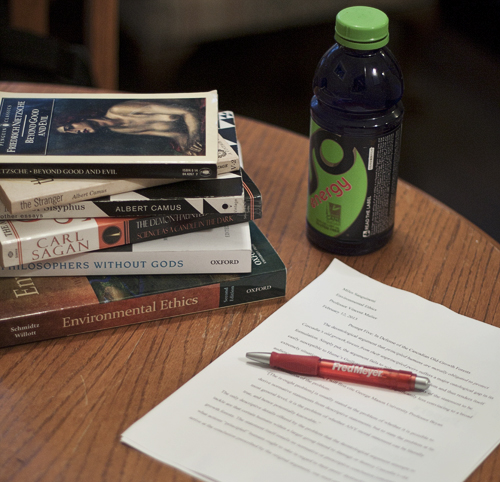Over the next few weeks, Portland State will be abuzz with frantic students who are pushing hard to make sure their final projects and papers are done before oh-so-intimidating finals week.
How many pages? What’s the format?

Over the next few weeks, Portland State will be abuzz with frantic students who are pushing hard to make sure their final projects and papers are done before oh-so-intimidating finals week.
So what goes into writing a good paper?
Paper guidelines will vary by professor, discipline and style, but there are some universal tricks that will help you as you take on the onerous writing task.
The first step is to make sure you understand your assignment. Rather than just reading it, take the time to break it down and ascertain what questions are being asked. Too often, not all questions are seen or understood. If you have any questions about the assignment, ask your professor for clarification.
After you understand the assignment, write your thesis statement. This shouldn’t be too long, only two or three sentences, but it should provide the reader with the underlying theme of your entire paper.
Only after you have written your thesis should you do your research. I order the steps this way because you cannot guide your research or evaluate sources if you don’t know what you want to say.
While doing your research, be sure to use all available resources. Don’t just do a quick Google search and choose the top responses. Go to the library and ask for a reference librarian’s assistance. Ask your fellow classmates for ideas. You can even ask your professor for some advice.
By limiting yourself to just one research approach, you cut yourself off from really developing a cogent paper. Don’t be afraid to gather lots of resources; even if you don’t cite all of them, they can only help to build your paper’s strength.
After you’ve gathered sufficient material, write an outline. Some of you may not like writing one—I used to think the same way, but I’ll attest to their utility. An outline gives you the ability to organize your thoughts in a logical manner without having to rewrite sections multiple times. It can also serve as a place to gather your research notes and insert quotations and their citations.
Now that you have a thesis statement—which may have been revised as you narrowed your research—your relevant research and your completed outline, it’s time to start writing. A writing teacher once shared a very useful mnemonic with me that really helped: ESSAY.
The “E” stands for “explain what you are going to say”; the next three abbreviations are for “some information,” “some more information,” and “additional information”; the “Y” is for “yank it all together.”
After you’ve written your first draft, take a night and sit on it. Then go ahead and read it through. Pay attention to grammar errors and how well the paper flows. Then take it to the PSU Writing Center and have them look it over. Then take it to a friend. Then take it to another friend.
The important thing is to have it reviewed multiple times so that grammar and errors in logic aren’t overlooked.
Incorporate any needed fixes into your next draft and do the editing phase again. Repeat as many times as is necessary, or until you’re happy with your writing.
The last step is to get the final draft ready. This involves more than just printing it out: Give it another once-over and make sure there are no glaring spelling or grammar errors and that your argument flows logically from one point to the next.
When it does come time to print your paper, make sure to use a quality printer. I’ve had papers graded down because my printer smudged the ink. The printers at the library are perfect and you have a 500-page print quota that you’ve already paid for via your student fees. You even have the option to print in color if you need it.
Finally, you can turn it in and breathe, and maybe even catch up on that sleep you’ve missed.








Nice, USEFUL opinion essay. Thanks Joseph. –jh